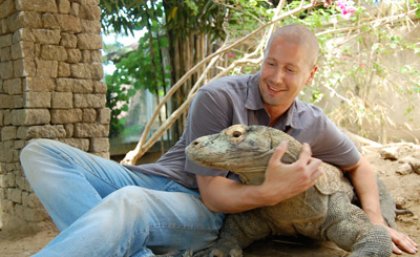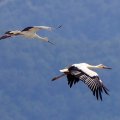
A team led by a University of Queensland researcher has proven that the fearsome Komodo dragon is a victim of bad press.
It has long been believed that Komodo dragon bites were fatal because of toxic bacteria in the reptiles’ mouths.
But ground-breaking research by The University of Queensland’s Associate Professor Bryan Fry and colleagues in the United States has found that the mouths of Komodo dragons are surprisingly ordinary and the levels and types of bacteria do not differ from any other carnivore.
This presents a powerful challenge to how most scientists and zookeepers have viewed the Komodo dragon.
“Komodo dragons are actually very clean animals,” Associate Professor Fry said.
“After they are done feeding, they will spend 10 to 15 minutes lip-licking and rubbing their head in the leaves to clean their mouth.
"The inside of their mouth is also kept extremely clean by the tongue.
“Unlike people have been led to believe, they do not have chunks of rotting flesh from their meals on their teeth, cultivating bacteria.”
In fact it seems the poor hygiene of water buffalo is responsible for perceptions about deadly toxic bacteria in the dragons.
Komodo dragons evolved in Australia and preyed upon young megafauna.
They now populate the islands of Indonesia where they prey on the introduced water buffalo, and on pigs and deer.
Professor Fry said attacks on pigs and deer were extremely successful, with about 75 per cent bleeding out within 30 minutes and a further 15 per cent dying within three to four hours from venom in the salivary glands of the Komodo dragons.
“In contrast, water buffalo always get away but with deep wounds to the legs,” he said.
“The water buffalo follow their instincts and seek shelter in warm water that is usually stagnant, filled with water buffalo faeces and flourishing with bacteria, particularly nasty anaerobic types.”
Pathogenic bacteria found in komodo mouths were simply the remnants from when the dragons drank from sewage filled watering holes. The dragons do not have enough bacteria in their mouths to infect an injured water buffalo.
"It is when the water buffalo go stand in the toxic water with gaping wounds that they get infected," Professor Fry said.
"It really has been that simple all along.
"If water buffalo had never been introduced onto the islands, then this enchanting fairy tale never would have come into existence.
“The water buffalo are not living in their native habitat of large fresh marshes but rather on islands with the only water source being tiny water holes.
“So they are basically going to the bathroom directly onto their wounds. This is an ideal scenario for infection, but a situation that is man-made and thus entirely artificial.”
Professor Fry says the next step is to conduct tests on the watering holes to prove that they are the true source of any infection to water buffalo and to characterise what sorts of pathogens are responsible for the sickness to the water buffaloes.
The findings from Associate Professor Fry and his colleagues are published in the Journal of Zoo and Wildlife Medicine.
High resolution Images are available from Tracey Franchi.
Media: Associate Professor Bryan Fry, 0400 193 182 or bgfry@uq.edu.au or School of Biological Sciences Communications Manager Tracey Franchi t.franchi@uq.edu.au or 3365 4831.
About the School of Biological Sciences
Through research undertaken in the School, UQ has been ranked by the 2012 National Taiwan University Rankings in the top five universities globally for research in ecology and environmental biology and in the top 18 universities globally for plant and animal biology. The UQ School of Biological Sciences attracts researchers of world standing in a range of disciplines, with international leaders in many diverse fields. Our work spans the scales of biological organisation, from molecules and cells to organisms, populations, species and communities. With more than 150 researchers working in evolution, global change biology, ecology, aquaculture, animal behaviour, physiology, entomology, zoology, botany, genomics, development and conservation biology, our researchers and graduate scientists are well-equipped to make a real difference in contributing to solving global problems.
.jpg)









